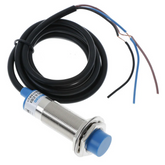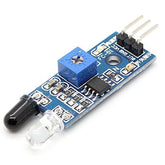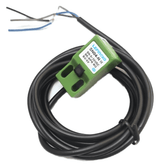How to Choose the Right Proximity Sensor for Your Project
Summary
Discover the essential steps to selecting the perfect proximity sensor for your project in our blog, "How to Choose the Right Proximity Sensor for Your Project." From grasping the fundamentals to identifying project requirements, exploring sensor types, and analyzing range and accuracy needs, this guide covers it all. Dive into considerations like environmental conditions, response time, and integration compatibility. We'll help you navigate cost-performance trade-offs and assess installation/maintenance ease. Don't miss the conclusion for a comprehensive overview. Make the right sensor choice – read now for precision and efficiency in your projects!
Introduction
When working on a project, selecting the proper proximity sensor is crucial to guarantee optimal performance. Proximity sensors come in various types—each with specific attributes designed for different applications. Understanding these differences helps ensure you pick one that aligns perfectly with your project's needs.
From capacitive and inductive varieties to ultrasonic and photoelectric options, assessing factors such as range, target material, environment conditions, and size requirements directs you toward making an informed choice suitable for seamless integration into your design.
Understanding Proximity Sensor Fundamentals
When we dive into proximity sensor basics, it becomes clear that choosing the right one is all about context. Take ultrasonic sensors; they excel outdoors where light doesn't play tricks on them because, well, they listen with sound instead of looking with light.

Now imagine you're setting up a system in broad daylight or dealing with transparent objects—ultrasonic is your friend here. Let's shift gears to something like optical Time-of-Flight (ToF) sensors.
These gadgets are top-notch when distance matters—they can see far and focus tight on what’s ahead. They fit perfectly if you’re crafting precision equipment like drones needing pinpoint landings. But sometimes, more than just range or lighting conditions matter—you need details about movement and angle too.
This is where millimeter-wave (mmWave) technology shines brightest! It dishes out info other sensors simply can’t match—like how fast an object moves towards a door and from which direction it comes at the gate—not merely its presence. Each type has unique strengths. Some save power for doors that shouldn't swing open with every casual passerby; others operate tirelessly next to humans, ensuring safety in regulated slowdowns instead of full stops. So yeah, picking the right proximity sensor? It's not as simple as grabbing any off-the-shelf part for your project.
Read our blog about how does a proximity sensor work where we discuss what are proximity sensors, features of proximity sensors, how does proximity sensor work, and the different types of proximity sensors.
Identifying Your Project Requirements
To pick the right sensor, you first need to list what your project requires. Think about size; this matters a lot. Then there's material detection - some sensors work better with metal or plastic than others do. It's key to choose one that suits your job. Next up is power consumption.
Your choice should match how much juice you can give without wasting energy or overheating components in tight spaces. Lastly, think on interface needs; does it link well with your system? Some tech talks easier with certain gadgets and software over others. It all boils down to knowing these bits: How big? What will it meet each day? How much power needed? And how must it connect? Lay these out clear as day before diving into options for the best fit.
Explore the various types of proximity sensors used in robotics.
Check out our collection of sensor!
Exploring Types of Proximity Sensors
Proximity sensors come in various types, each with unique abilities. Infrared sensors detect heat and are great for finding warm objects moving nearby.

Capacitive ones sense changes in electrical fields; they're top-notch when you need to spot non-metal stuff like plastic or glass without touching them. Inductive versions excel with metals, reacting to any metal object that comes close—perfect for machinery use.
Ultrasonic proximity detectors emit sound waves that bounce off surfaces. They "see" by measuring the echo's return time, which is effective even in dusty environments. Photoelectric options work using light beams; if something breaks the beam between a sender and receiver unit — bam!

The sensor knows there's an object getting up close and personal.
Learn more about the different Proximity Sensor Types
Analyzing Sensing Range and Accuracy Needs
In picking the right proximity sensor, think about how far and how precise it needs to be. Every project demands a range where sensors work best. Some need to spot things close-up, others at a distance. The key is balance: enough reach without losing detail in reading.
Say your task is counting people walking by; you want no mistakes there—accuracy matters. Now let's talk numbers for sensing distances. They vary from mere millimeters up to several meters—it all depends on what you're after. In industrial setups, precision could mean less than a centimeter of error allowed. So here's my tip: look at specs closely for 'sensing range' and 'accuracy'.
This will tell if the sensor fits your project exactly—or not quite right—which saves time and stress later on when everything’s gotta run smooth.
Also, read our blog Proximity Sensor Types detailing 5 types of proximity sensors and their working principles.
Considering Environmental Operating Conditions
When we pick the right proximity sensor, where it sits matters a lot. Heat can be trouble – if my sensor gets too cozy with something hot, its life shortens and suddenly I'm neck-deep in repairs. So what do I do? Well, there's magic in distance.
A little gap could save me cash and cut down on stress. Some sensors are champs at stretching that gap between them and their target; they come as extended or triple-range types—a big deal when you’re stuck with no room to mount your gadget up close.
These heroes range from 8mm sizes all the way to mightier 30mm ones for those extra-long reaches needed sometimes. Using one means not sweating over impossible tight spots or shelling out more dough for heat-proof models—nope! We've got a wild machine part flying about.
It's key to keep our trusty sensor further back to stay safe in these moments. Crafty tech in plain steel boxes performs a neat trick. It spots things from afar like usual round sensors and fits snugly in tight spaces without flush fitment issues. And here's food for thought - ever think of putting your gear underwater? Or maybe somewhere oil plays splash-tag every day? This choice bit hinges directly on picking a design tough enough not to throw in the towel under such adventuresome conditions.
Assessing Response Time and Frequency Demands
In my search for the best proximity sensor, I've looked into how they're made. Turns out, those with nanocomposites are key. These sensors use a matrix mixed with active parts to spot what's close—be it physical or chemical stuff around them.
It's not just about finding problems but pushing sensor tech further. I found that blending different nanocomposites can tweak detection reach and up precision too; makes sense for more uses as well—a big win! Plus, these tiny changes in conductance matter a lot for how sensitive our sensors will be.
Now think wearables—I'm talking healthcare monitors and smart home safety gadgets—they need flexible, reliable sensors too. Good thing is that advancements in stretchy materials mean we might soon see implantable devices using this tech as well! So yeah, knowing all this helps me pick better when searching through various types of CPSs (Capacitive Proximity Sensors) needed across industries like robotics or shipping—and definitely essential if you want smoother interaction within your own innovative project.
Integrating with Existing Systems Compatibility
In our quest to find the right proximity sensor for a project, it's key we factor in how well it'll mesh with existing systems. For instance, ultrasonic sensors don't rely on light but sound waves; they excel outdoors regardless of sunshine or shade.
They detect things near and far—solids as well as see-through materials like glass.
On another note are optical ToF sensors; famous for tackling long distances over 20 meters! Their focus narrows down precisely, wonderful for tech that needs pinpoint accuracy from afar. Plus there’s mmWave technology—a true powerhouse delivering detailed data about an object's location and movement all at once.
Evaluating Cost Versus Performance Trade-offs
In choosing a proximity sensor, we weigh cost against function. It's like picking the right tool for a job; you don't want to overspend or undershoot your needs. Take ultrasonic sensors – they shine when light can't mess with performance because they use sound waves.
For jobs needing clear detection of things in bright light, think outdoors; these sensors are stars.
Optical Time-of-Flight (ToF) types have another edge: distance isn't an issue, reaching out up to 20 meters away! Lastly, there's mmWave tech – smart enough not just to detect but also tell speed and angle.
Its built-in brain means fewer parts needed elsewhere – saving space and cash without skimping on smarts. Each kind has its perks—our goal is finding that sweet spot: maximum benefit without wasting money.
Determining Ease of Installation and Maintenance
Considering how hot things can get, you want your sensor far from any heat. Heat kills sensors fast and means more fixing up. Think about using bigger range ones to keep it cool—like those 8mm-30mm or the beefier 8mm and 12mm triple range types.
Let's say you're stuck with a spot that's not close enough; these longer-distance pals are lifesavers for keeping your gear going strong. Sometimes stuff moves too much, right? Now if our gadget is set back a bit, no more bumps mean we help it last longer—that’s smart thinking!
Remember this: extended distance equals less hassle plus savings on repairs or pricier high-temp options out there. You got something tough to detect? Our special steel tech won't let you down—it spots most materials at full stretch just fine in its unique shell style housing! And hey, where exactly is this thing gonna live? Underwater adventures or oil baths maybe? Choose wisely; the place matters as much as what type of shield fits best—for tucking away flush against surfaces or stretching sensing further without one.
Selecting the right proximity sensor for your project hinges on understanding specific requirements like sensing range, target material, environmental factors, and output needs. Always consider whether inductive or capacitive sensors best fit your application. Take into account size constraints and installation space too. Robustness against external influences such as dust or moisture is crucial for reliability. Assess all these variables carefully to ensure optimal functionality for your design's particular demands—a step that ultimately drives success in automated systems where precise detection plays a pivotal role.
Read our blog interfacing proximity sensor with arduino where we explained the process of interfacing proximity sensor with arduino with the code.
Conclusion:
Selecting the perfect proximity sensor demands a strategic blend of technical insight and project-specific considerations. By navigating through the fundamentals, identifying precise project requirements, and scrutinizing sensor types, ranges, and accuracies, you pave the way for optimal performance. Environmental conditions, response times, and compatibility factors must be weighed, all while balancing cost and performance trade-offs. As you finalize your decision, don't overlook the importance of seamless integration and easy maintenance. Your sensor choice is not just a component; it's a key determinant of project success. Choose wisely for precision, reliability, and efficiency in every proximity-driven endeavor. Make the right click – your project deserves it.
Please do check out other blog posts about Popular electronics
Make sure you check out our wide range of products and collections (we offer some exciting deals!)










